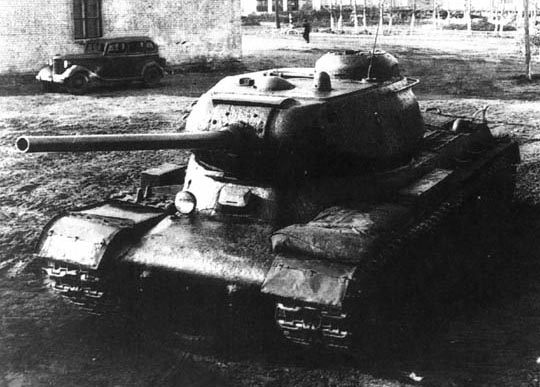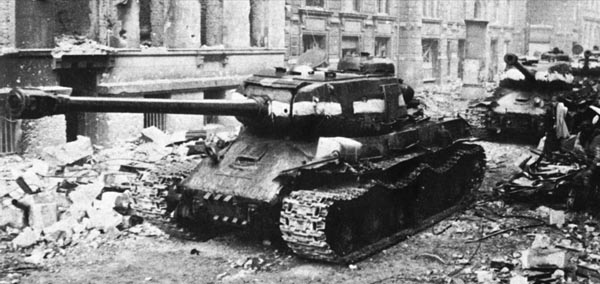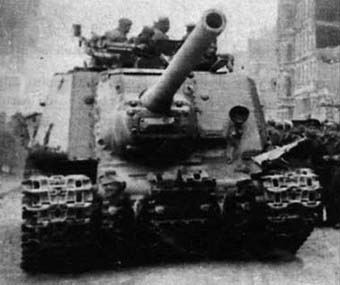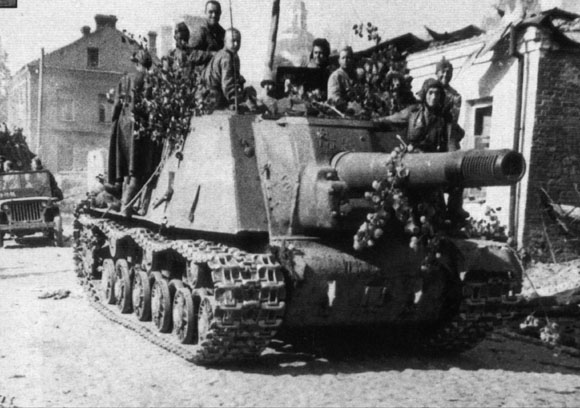|
|
|
|
Advantages: heavy armor protection, mobility (autonomy, diesel engine, large tracks), powerful gun (adequate against all german panzer), reliability because being built on a proved design
Disadvantages: limited ammo supply
The heavy tank rivitalized ...
The Iosif Stalin heavy tank series was born as the KV successor in the Heavy Assault Regiments. The KV-85 design was only a fill-gap measure for waiting a new tank for which Stalin himself showed much interest. Starting from the aborted KV-13 universal tank (from which took many mechanical parts and designs) the IS tank finally returned to a full sized heavy tank. The suspension was downed and the trasmission improved while a new cast armor gave a 50% more protection and a better ballistically shaped 100mm thick turret created a powerful tank. The growing use of casted and melted parts and the reduction of the turret armor thickness helped to maintain tghe weight around the 44 tons, nevertheless the increase of the armored protection on the front (120mm) and sides (90mm).
 |
IS-II armor scheme (Photo by Valera Potapov) |
The weak transmission has been a common defect of the KV heavy tank serie, so a new gear box, lighter and more flexible, was used and a new driving mechanism, more agile, adopted. The engine saw its raw power decreased to 513hp but the speed was still relatively high (37 Km/h) with an autonomy of 241 Km. Hull machine gun was removed to make room for the main gun's oversized rounds and was composed by four members: commander, driver, gunner and loader/radio operator.
First models appeared in November 1943 armed with the 85mm L51,2 gun as the KV-85 (IS-85); on the end of the same year the 100mm L60 gun tank (IS-100) appeared. There are no confirmed notices about this tanks being committed in action, but it seems that 104 went under rebuilding with new 122 mm gun.
 |
IS-I/85 heavy tank |
The previous models were only a stop-gap measure: the 122mm L43 D-25 (Model 43) gun was selected as main weapon of the tank although being less powerfull than the 100mm for armor piercing capabilities because it was easier to manufacture for russian industry and its priorities. It was installed in a more heavily protected (102mm) turret while the hull remained the same: this model is also known as the IS-122 or IS-1/122. 102 early tanks were taken to the new standard by upgunning the weaponry. To make the German intelligence's job more difficult both designation were simplified in IS-I for early models and IS-II for the newest.
The heavy tank units
With the new 122mm armed models became available in February 1944. They were grouped in ad-hoc formation named OGTTP, the separate Guards heavy tank regiments. Each regiment was formed by 21 tanks on five companies with 5 tanks each (each company was the divided in two platoons of two tanks plus a commander's tank). These regiments, referred as 'breaktrough regiments' by the Germans, were employed only in assaults against heavily protected defences and were assigned to Army or Front level commands.
The first known operation which saw the IS-IIs took place in Romania in April 1944 were the newly formed 11th Separate Guards Heavy tank Regiments fought several skirmishes against the s.Pz.Abt. 503. A Soviet tank was knocked out but the Germans could only take a brief look at it before being forced to retreat. A month later, ever in Rumania, near the town of Tirgu Frumos, another engagement along the line of the Soviet strategic trust in the Southern front took place. Tigers from the Gross Deautschland Panzergrenadierdivision engaged the IS-2s on long ranges.
General Hasso von Manteuffel, commander of the German Korps in the area, said: "It was a surprise discovering that, while my Tigers started to hit them from a 2,200 metres range, our projectiles were not able to pierce them until we got to about half of such a distance. But I was able to counter their technical superiority by manouvering to use in the best possible way the ground cover."
He intended that the Russians failed to hit small targets over the 1,200 metres: this was undoubtely due to the IS' poor aiming system and the usual difficulties to lock the target on long ranges. But it was certainly a bad surprise for the Tigers' crews (and for that handful of Tiger IIs just entered in service) to receive a 122mm 56 pounds projectiles fired by an IS-2. On 2,000 metres the 122mm was able to pierce the Tiger's front armor. The Germans could not fire anymore while standing up on their tanks.
|
||
Up: IS-II heavy tank, Hungary,
December 1944. Note the KV-13 front hull casting.
|
Effectively the new Soviet units were managed by inexpert or untrained (about this new vehicle) personnel but the impact of the new tank was formidable. Front units required more of them, and this took the production to be rapidily expanded to permit each Tank corps the have at least one tank regiment.
On June 22nd 1944 Operation Bagration took place. The Soviets had been succesfully in making the German High Commands to move its armored reserves southward. High secrecy, a peculiarity the Russians were able to keep over the German reconaissance and intelligence, take the Army Group Center to be mainly an infantry force. Four heavy tank regiments (2nd OGTTP with the 1st Baltic Front, 14th and 35th OGTTP with 3rd Bielorussian Front and 30th OGTTP with 1st Bielorussian Front) acted in the operation and two of these (2nd and 30th) gained great honors being granted of the names of the towns they helped to free.
At the end the whole German Army Group has been annihilated and in late Summer the Soviets reached the outskits of Warsaw before increasing German resistance, prolonged supply ways and heavy losses did them to have a pause. The Wehrmacht had suffered its most decisive defeat.
The Stalin regiments were used, as the German heavy tank battalions, in the most critical points of the front. But while the Germans' were used as defensive fire-brigades the Soviets' were employed in breaktrough operations. The fronts where these breaktroughs had to be archieved were chosen where the German tank forces were particularly weak. In this way, the heavy tanks saw little tank-vs-tank fight: their true enemy became the infantry weapons, particularly the Panzerfausts and Panzerschrecks along with the towed PaK 40 75mm anti-tank gun.
In late 1944 there was a fair number of IS-IIs to form Guards Heavy Tank Brigades. Each Brigades consisted of 65 IS tanks, 3 SU-76 light assault tanks, 19 armored transporters and 3 BA-64 armored cars. These few units were intended to be used as assault fortified lines with heavy infantry and engineers support. The first units were ready to have a part in the last offensives in 1945 against Germany while the increased tank production make possible each tank corps to receive a regiment of IS-2s.
|
||
This was one of the first IS-2 knocked out and recovered by the Germans, probably near Tirgu Frumos, in Romania in May 1944. On the hull and turrets there are their thickness and slope (from the vertical as German practice). |
The IS serie, along with the KV and all the assault guns derived from them, formed a massive contributiuon to the Red Army. As all the Soviet tanks, they were built rawly manufactured wiith the mind pointed to the essential, but what they lacked in sophisticated weponry was more than balnced by the power of the large calibers. They had to pay for the limited ammunition load, but the IS tanks represented an reliability and mobility model their opponents could not match. As conseguence they were able to give a well protected heavy fire power which played a vital role in the Soviet offensives leading to the fall of Berlin.
Stalin tanks and the German heavies
While the anti-tank role was not as primary as the infantry support role the IS tanks had to front the German Panthers, Tigers and Royal Tigers. Their 122m gun was a good anti-tank weapon but it still lacked of the armor piercing punch . Several projects were carried to re-equip the tank with a more performing gun: discarding the 85mm gun (also in tis improved versions) the only real alternative was the 100mm D-10 gun. Still the industrial facilitation in having a great reserve of 122mm tubes and ammunitions and the 100mm's lack of support took the previous gun to be retained.
Survivability is a fundamental. It is usually forgot that a tank (and its crew!) nevertheless being heavily armored and gunned, may always being hit, immobilized under enemy fire, etc. It could take fire or not (and IS-II greatly reduced this thanks to his Diesel engine), ammunition could ignite and blast it but wheter or not these things happen a reasonable chance for the crew to escape dangers must be given. German tanks had two hatches in the turret (commander, gunner and loader) and two in the hull (for driver and marconist). IS II only had two, both located in the turret making the driver's chance to escape, to say at least, difficult (although there was no turret basket to divide the turret from the driving compartment).
 |
IS-IIm heavy tank in Berlin's ruins |
The Panther and IS-2 guns had a roughly equal armor piercing capability on ranges of 1,000 metres while the Soviet 25Kg HE shell performed much better than German 4.7Kg one. Stalin enjoied a superior all-around protection while having about the same weight. The 122mm shell was able to pierce Panther's front plate on a range of over 1,000 metres while, according to Panther's crew manuals, the German had to get close to 600 metres to score a sure hit over the Russian. Both tanks could pierce each other flanks from range up to 2,000 metres. The Panther's advantage in speed (46 Kmh versus 37 Kmh) should be considered in formation and manouvered combat.
The confrontation between the Tiger I and the Stalin also take an advantage to the Stalin. It have better armour, lesser dimensions, lesser weight, bigger gun. But this have a price: Stalin was much more cramped and could take less then one third of the ammunition carried by a Tiger and the German tanks had a much faster rate of fire. On a 1,000 metres range they could knock out each other but going to a range of 1,500 the IS-II could take out the Tiger while remaning untouched. However these are theoritical values: Soviet poor optics devices make them difficult to obtain and much of the engagement's results depend upon the individual crews' experience and skill.
The comparison with the Tiger II is more difficult: the German tank was much more heavily armored, had long barreled 8.8 cm gun capable to knock out an IS-II well over the 2,000 metres, a distance making it invulnerable to return fire. Luckely for the Russians the European ground in which the Tigers operated was not optimal for them, with the most of the engagements taking place at ranges of 500 metres. Between the two tanks there were only minor skirmishes in Hungary when the s.Pz.Abt. 503 entered in action. A major encounter took place in Germany on January 12th 1945 during the Soviet offensive towards the Oder river. Tiger IIs of the s.Pz.Abt. 524 exchanged fire at short ranges with the Russians resulting in both sides catching heavy losses. Tiger II had a faster rate of fire, superior armor and fire power and only Soviet advantage was a lightly better speed and a superior all-around mobility (expecially while speaking on the logistical plane).
New heavy assault guns
The stunning success of the old SU-152 could not subtract the IS chassis from being used as basis of new family of assault guns. New vehicle was similar to the previous but a little higher. Ammunition payload was the same so only 20 rounds could be carried inside the ISU-152. The same surplus of 122mm gun tubes led to the decision to mount this weapon also on this assault gun resulting in the ISU-122.
 |
KV-1 model 1939 armor scheme (Photo by Valera Potapov) |
The heavy assault guns were grouped in Separate Heavy Assault Guns Regiments (OTSAP) with four batteries and 21 tank in all. There was no distinction between the models carrying different guns so these units were often a mixture of these. The employement of this formations was not different from the use of the OTTGPs: they were massed in carefully chosen points of the front and had to assist major breaktrough operations.
Their primary targets were strongpoints and AT defences which they hit from long ranges: close fights had to be avoided because the limited traverse gun made them vulnerable to flank attacks. Lack of MGs also made them vulnerable to close infantry assaults although strong infantry support was provided. When German armor was encountered ISUs were commonly engaged in ambush role, always firing from long ranges.
 |
ISU-152 heavy assault gun |
Their anti-armor performaces were adequate for the role with the 152mm round being able to pierce a 120mm plate on 1,000 metres range and 122mm one being able to penetrate 160mm at the same distance. Because of its inferior penetration performace the ISU-152 was often relegated to infantry support role, where their big HE rounds could take the greatest advantage.
ISU-122 abd ISU-152's first major commitment was, as for the IS-IIs, during operation Bagration which saw 14 Guards heavy assault regiments in action. Soon the assault guns gained reputation being able to be classified among the deadliest enemy of the German Tiger I tanks. Of the 12 tanks lost by the s.Pz.Abt. 502 in Summer 1944, about half was catched by ISUs.
The ISU-122 was initially armed with the A 19S gun, a simple conversion of the artillery piece of the same caliber, and then with higher fire rate D 25S as the most recent IS-II models (six shots/minute against three shots/minute). Over 2,000 assault guns based on the IS chassis were built, proving to be a very effective design, in both performances and reliability.
 |
The impressive shape of ISU-152 |
This page is online thanks to Geocities, the largest Web Community! Get your own free page at Geocities!!! |